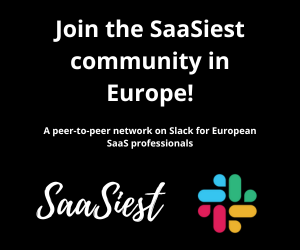Rasmus Holst, CEO of LMS365, could have aptly titled his SaaSiest 2023 talk, “How to expand your company on someone else’s balance sheet.” His presentation, “Best distribution strategy wins,” answers the question of how to grow ARR and expand geographically even if you don’t have the best product.
Takeaways
- You don’t have to have the best product, just the best distribution strategy to expand your business.
- Meet prospects where they already are.
- Find distributors that are a great cultural fit.
- Forget winning the negotiation when it comes to partnership fees. Pay them well so they’re motivated to drive revenue from your product.
- Look at distributors as future M&A opportunities. You’re essentially expanding your business on someone else’s balance sheet, then buying back your revenue to dramatically increase your own company value.
What to do when you don’t have the best product
Rasmus didn’t pull any punches, opening with what he called the “most disappointing piece.” And that is: what if you don’t have the best product? What are you going to do to scale and grow your revenue? The good news is that even with a product that’s not best-in-class, it’s possible to reach bigger markets with the right strategy. (IKEA, we’re looking at you.)
Be the best at meeting users where they are
First and foremost, find a distribution strategy – a scalable framework – that gives you leverage for profitable growth. Figure out where the most cohesive group of people are doing the same thing on the same platform, then meet them there. For example, during the pandemic, 350 million professionals congregated on Microsoft Teams, 300 million of them every day. If you have an application that professionals need to use every day, why not meet them where they are? It’s a great way to distribute your software.
So how do we reach bigger markets? How do we scale outside the Nordics? Be the best at meeting users where they are and be the best at distributing to users.
Figure out your expansion strategy
Many companies’ knee-jerk reaction is to hire a VP of sales in the country or region you want to expand into. But think about all the companies with software already embedded in the organization. Build your global expansion strategy using those networks already in place to de-risk funding when you invest in a new region.
Find a market where usage of an embedded product is high (in LMS365’s case, Microsoft Teams). Look at the distributors in the market who know a set of customers they can talk to every day who meet your criteria. LMS365 uses this approach as part of its expansion strategy as a Danish company with 50% of its business from the U.S., 35% from Europe, and 15% from the rest of the world. With fewer than 20 salespeople, LMS365 was available in 60 markets.
Look at distributors as future M&A opportunities
Most companies with distributors try to optimize partner fees for themselves. However, it’s beneficial to look at the distributor relationship as part of your expansion strategy in a different way.
For geographical expansion, you want a team that you know is a great cultural fit. And once you’ve identified those distributors, ensure they’re well paid for the job they do, because these are essentially M&A opportunities. LMS365 acquired its North American distributor, German distributor, and Australian distributor over three years. Those distributors represent the largest, third-largest, and fourth-largest Microsoft Teams markets in the world. While distributors are usually cash-flow positive, they do not own intellectual property, so they are typically valued at a 1-2x multiple, and they have no exit. If you can make a distributor dependent on selling your product and they like you, they will want to be part of your business. And you’ll know from working with them whether they’re a great cultural fit and can sell and service the product.
If you buy a million dollars in ARR from a distributor that you’ve generously handed them through partner fees, you essentially buy back your own revenue and get a higher multiple. Your company is worth more, and you’ve solved the geographical strategy.
You actually get to play ‘private equity business’ if you’re smart about it. You can use the partner margin for your earnout. What if you had some distributors, but they now get the 30% earnout as an earnout of the revenue they’ve built in three years? You almost make it a cash-to-ARR equal that you pay for. This trick has enabled LMS365 to operate and geographically expand in a cash-neutral way for the last 10 years. It’s a playbook.
As an example, there was once a Danish company called Navision. They built everything into Microsoft and used the Microsoft distributor ecosystem to distribute a ubiquitous product. They built up their revenue and a partner ecosystem of 2,300 that they gradually acquired back. Navision scored a $2.5 billion exit to Microsoft as a result.
Use distribution as a foundation for profitable expansion
So ask yourself, Do I really need the best product or do I need the best distribution? How can I geographically expand? How can I make sure that I don’t make an investment in a region that will fail? How do I use the proceeds from a VC funding round cleverly, and how can I actually make sure that this growth is sustainable? This type of distribution strategy could be a model for you.
Use distribution as a powerful foundation for both geographical expansion and ARR expansion, profitable growth, and a way to ensure that when you move into other markets, you have a baseline of people you trust and can count on to continue to grow your markets.
Forget winning the negotiation when it comes to partnership fees. Even if you give away 50% of your revenue, if your ultimate strategy is to rebuy that, you’re not giving it away. You’re just building your region on someone else’s balance sheet.
To hear more of Rasmus’s SaaSiest 2023 presentation, check out his video on SaaSiest TV.




